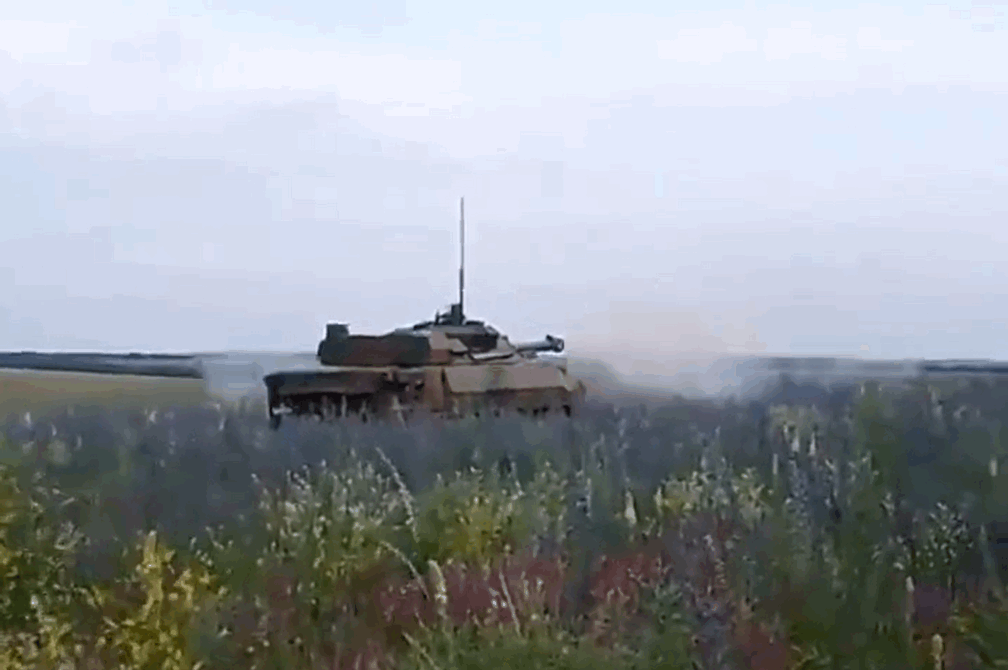The Ukrainian marine corps is using its French-made AMX-10RC reconnaissance vehicles as artillery, deploying them behind the front line and leisurely aiming their 105-millimeter guns at Russian positions.
A video that appeared online last week depicts a platoon of AMX-10RCs firing their main guns from an open field in broad daylight, while a separate video from inside one of the vehicles underscores the crew’s unhurried attitude.
It’s obvious the AMX-10RCs aren’t in much danger from return fire. They’re far enough from the enemy that they can shoot and scoot before anyone shoots back.
This isn’t the role French firm GIAT designed the 15-ton, wheeled AMX-10RC for—nor is it the role French forces usually assign to the type. But barring a major breakthrough by Ukrainian marines onto open terrain—an unlikely contingency given where the marines are fighting—it might be all the four-person AMX-10RCs can handle.
Last winter, France pledged 40 AMX-10RCs to the Ukrainian war effort. The pledge came as Ukraine’s foreign allies were scouring their vehicle parks and warehouses for armored vehicles they quickly could donate.
The United Kingdom offered Challenger 2 tanks; Germany pledged Leopard 2 and Leopard 1 tanks and Marder infantry fighting vehicles; the United States pledged M-1 tanks and M-2 and Stryker IFVs.
France’s donation of AMX-10RCs stood out. The AMX-10RC isn’t a tank. It isn’t a fighting vehicle. No, it’s a lightweight reconnaissance vehicle. As designed, it operates in small groups, speeding ahead of the tanks and IFVs in order to probe enemy defenses.
An AMX-10RC isn’t supposed to stand and fight; it’s supposed to sneak around, fire a few rounds, provoke a response, register enemy positions and then speed away. Which is why GIAT emphasized the vehicle’s speed and optics and deemphasized its firepower and armor protection.
The AMX-10RC has an accurate and effective main gun—but the gun lacks stabilization, meaning the vehicle must halt before shooting. However, the AMX-10RC’s greatest weakness is its thin aluminum armor, which offers the equivalent of just a few tens of millimeters of steel
The problem, for the Ukrainian units that took ownership of the AMX-10RCs—the 37th Marine Brigade, for one—is that, early in their long-planned counteroffensive, which kicked off across southern Ukraine on June 4, they didn’t need ground reconnaissance vehicles. After a year of intensive drone surveillance, they knew where the Russians were.
Pre-counteroffensive aerial reconnaissance rendered moot the AMX-10RC’s primary function. But inexperienced Ukrainian officers, apparently keen to make use of all of their recently-donated Western equipment, deployed the AMX-10RCs, anyway.
When the 37th Brigade and other units pushed across Russian minefields and pre-sighted artillery kill zones toward Velyka Novosilka in southern Ukraine’s Donetsk Oblast in early June, the AMX-10RCs were in the lead.
The results were predictably tragic. At least two, and perhaps as many as four, of the AMX-10RCs were immobilized or destroyed. Russian forces captured one of the immobilized vehicles.
At least one four-person AMX-10RC crew died, a marine major told AFP. “There was artillery shelling and a shell exploded near the vehicle. The fragments pierced the armor and the ammunition set detonated.”
The marines learned their lesson. “The guns are good, the observation devices are very good,” the major said of the AMX-10RCs. “But unfortunately, there is thin armor and it is impractical to use them in the front line (attack).”
It should come as no surprise that, as the Ukrainian marines finally broke through Velyka Novosilka and fought their way south along the narrow Mokri Yaly River Valley—an effort that continues three months later—they led with T-80 tanks and British- and American-made armored trucks, and held back the AMX-10RCs.
But it was unclear what the Ukrainians were doing with the surviving three dozen AMX-10RCs until the recent video depicted them in the indirect-fire role.
To be sure, the French vehicle is a solid shooter. When the first AMX-10RCs began arriving in Ukraine back in the spring, then-defense minister Oleksii Reznikov described the vehicles as “sniper rifle[s] … on fast wheels.”
The combination of precise day-night optics and a reliable main gun means an AMX-10RC crew reliably can hit targets a mile away or more. And that’s while shooting directly. Elevate the gun and shoot ballistically, and the maximum range is 4.5 miles.
Don’t expect the same accuracy at that distance, of course. Firing from beyond visual range, an AMX-10RC functions as a kind of improvised, extra-survivable howitzer: aiming at target coordinates registered by drones or forward observers.
And it’s not alone. Those hundreds of 70-year-old T-54 and T-55 and 60-year-old T-62 tanks the Kremlin has pulled out of long-term storage and shipped to the front? They also are functioning as howitzers, respectively firing their 100-millimeter and 115-millimeter guns out to a distance of up to 10 miles. Ukraine’s Challenger 2 and Leopard 2 tanks are doing the same.
Omnipresent drones, mines and anti-tank missile teams have made the Ukraine front line a very dangerous place for tanks and recon vehicles. So more and more, the Ukrainian and Russian armies are deploying their big-gun armored fighting vehicles—recon vehicles and tanks alike—as artillery. It’s a compromise that protects the vehicles without wasting their firepower.
“They make for an inefficient form of artillery,” analysts Jack Watling and Nick Reynolds wrote about the tank-howitzers in a recent study for the Royal United Services Institute in London. “Nevertheless, these engagements can often be made from positions that would not be viable for artillery.”
The AMX-10RC works just fine in this compromise role. Which is fortunate for the marine brigades operating the type. Because the only other mission the recon vehicles are good at—speedy reconnaissance—is irrelevant as long as the front line is so stiff and over-surveilled … and there’s nothing for the vehicles to reconnoiter.
Read the full article here





